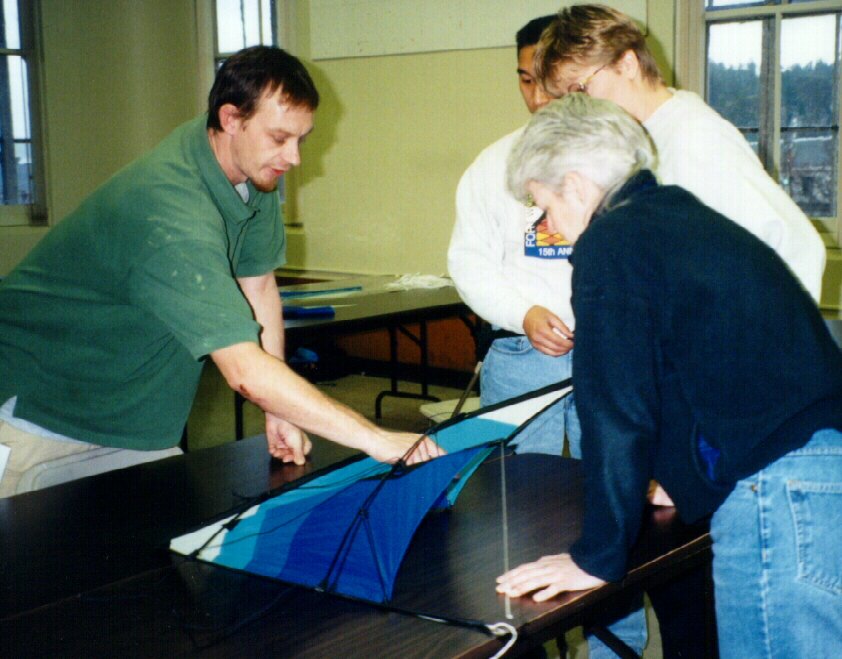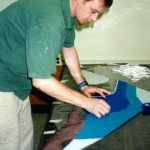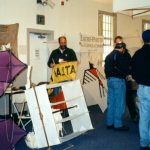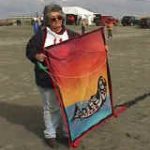16th Annual Fort Worden Kitemakers Conference
March 19, 20, 21 1999
Report by Elain Genser and Sharon Musto
 EG: SPRING FLING WITH WINGS: For the past seven years I have celebrated spring with a pilgrimage to Port Townsend, Washington for the Fort Worden Kitemakers Conference. When I first started attending, I lived in Prince George B.C., which was five hundred miles (or 12 hours driving) due north of Vancouver, and another 5-6 hour drive from Vancouver to Port Townsend. I would need to take nearly a week off work in order to drive there and back, but it was worth it! Living so far from other kiters, it was a welcoming start to the season, a time to connect with old friends, make new ones, trade pins, get new ideas, and shop in the on site kite shop for stuff that was impossible for me to get in Canada. Each year since, I have returned for my spring fling fix. Over the years I have seen the weekend event grow and develop into what has to be one of the U.S.’s largest kitemaking events. This year had to be one of the biggest in the number of workshop offerings, of people, and of raffle items!!
EG: SPRING FLING WITH WINGS: For the past seven years I have celebrated spring with a pilgrimage to Port Townsend, Washington for the Fort Worden Kitemakers Conference. When I first started attending, I lived in Prince George B.C., which was five hundred miles (or 12 hours driving) due north of Vancouver, and another 5-6 hour drive from Vancouver to Port Townsend. I would need to take nearly a week off work in order to drive there and back, but it was worth it! Living so far from other kiters, it was a welcoming start to the season, a time to connect with old friends, make new ones, trade pins, get new ideas, and shop in the on site kite shop for stuff that was impossible for me to get in Canada. Each year since, I have returned for my spring fling fix. Over the years I have seen the weekend event grow and develop into what has to be one of the U.S.’s largest kitemaking events. This year had to be one of the biggest in the number of workshop offerings, of people, and of raffle items!!
My first Fort Worden was a pretty overwhelming event, and now I guess I am an ‘old timer’. This year, I managed to talk Sharon Musto, editor of KiteLife, into coming to Fort Worden. It didn’t take much to convince her and I offered to pick her up and drive her down from Vancouver. There were a few problems with this, as I now live on Vancouver Island, and she lives some 2400 km away in Winnipeg, Manitoba. Careful planning included coordinating her flight with my ferry and we were on our way.
SM: Yep, this was my first kitemakers conference and I can see how it can become a habit! I took three days off work and added it to the weekend, only because I like to reach my destination early and not be rushed when it’s time to leave — which was a good thing, as we were at the mercy of tides and ferry schedules. (But that’s another story altogether…)
Port Townsend is on the Olympic Peninsula, and is reached by ferry boat from a point called Keystone. Parked and waiting for the ferry, we greeted easily identifiable workshop-bound people, and the weekend had begun!!! On arrival Thursday evening, we checked in at the reception house where we picked up information packages containing name tags, receipts, itinerary, T-shirt, etc. Organizers provided a great buffet meal for the tired travellers. As a newbie, I received a special memento: a handmade kite/tag to wear with my name tag. Nice touch. (Wooo hooo!! I’m really here!!) We snacked and chatted with new and old friends, signed the 1999 Fort Worden commemorative kite. Soon we were off to seek out our respective sleeping quarters and classrooms, to unload and get our sewing machines set up for 8 a.m. classes.
EG: At one time a visitor from the east was a novelty, but this year saw more and more attendees from east of the centre. This year Carol and David Robinson of the Whitehorse Kite Fliers returned yet again from England, and they brought with them a contingent of seven British kitefliers who added considerably with their presence and who contributed mightily to the auction table with generous and unusual kite offerings.
Fort Worden’s Spanish War era army camp buildings were undergoing renovations this year. As a result we were kicked out of our usual large central building and were scattered all over the campus grounds. This made it more difficult to connect with people, especially if you were involved in an all day workshop. The day workshops seemed to be offered in rooms that were way across the campus from most everyone else, thus isolating us. In addition, while many people were staying in the large dorms, many other groups were renting furnished houses in what had formerly been the officers’ houses. This also contributed to what seemed to be a lack of focus and togetherness that had been common in the early years. When everyone stayed at the dorm we partied and traded pins and just had fun till the wee small hours in the large common room. With the increase in numbers, and with more and more of the participants renting the officers’ houses, the only time we got together as a group was at meal times.
The less said about the meals the better. Fort Worden, while known for the very fine workshops, is even better known for its really lousy food. This year saw a change in service style from cafeteria to ‘sit down and wait to be served’ that only meant that most meals got to you cold or sometimes just didn’t get to you at all! As a result many ‘regulars’ now take their meals in town, or cook their meals in their residence. However, the big draw at meal times is the raffle, and everyone turns up after dessert is served!! At every meal the auction committee, led by the indefatigable Marla Miller and her team of bonny Brits, would display a selection of donated items. We deposited our raffle ticket in bags in front of the items we lusted after, and tickets were drawn after the meal. This year there was a record number of items donated and money raised (433 items, $6,379). The proceeds are used to finance the weekend and invite workshop instructors from abroad for next year.
Each year, one room is set aside for the Store. It is set up and stocked alternately by either Ken and Suzanne Conrad’s Great Winds Kites or Kathy Goodwind’s GasWorks Park Kite Shop, both in Seattle. This year it was Great Winds’ turn and they had everything you would need for any of the workhops PLUS!!!!
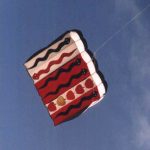 I took a full day workshop on Friday with Don Mock, and made a small version of the MockFlow. This 4×6 foot adapted flowform packs down into a delightfully small package which will make an excellent travel kite. It flies in the slightest breeze, and carries tails, tubes and laundry with ease. Many of the participants got their panels before the weekend and had the appliqued the faces ready when they arrived, so we were able to complete the project easily on Friday.
I took a full day workshop on Friday with Don Mock, and made a small version of the MockFlow. This 4×6 foot adapted flowform packs down into a delightfully small package which will make an excellent travel kite. It flies in the slightest breeze, and carries tails, tubes and laundry with ease. Many of the participants got their panels before the weekend and had the appliqued the faces ready when they arrived, so we were able to complete the project easily on Friday.
What I learned: *Read instructions before cutting!!! *How to put a complex cell kite together *A more efficient way to rip seams (which I excelled in!!); *Interesting language!!! (see above) *How to cut patterns out of arborite; *How stove top rings make excellent patterns for circles.
SM: I spent Friday in Randy Shannon’s class where we made small mask kites. A tribe of mask ‘faces’ greeted us as we entered the classroom, surrounding us! Randy had prepared kits consisting of red, white and black ripstop, pre-cut framing, and all the little bits and pieces that would go into the mask. He provided templates for cutting the sails and for drawing the faces, and gave us 11 pages of detailed instructions and diagrams.
What I learned:
*How to tie a very cool sliding knot for a bow line, eliminating the need for a line tensioner. It seems to be a variation of the tautline hitch, with a couple of extra turns; *A better way to hot cut perfect circles using heated brass tubing; *How to make “booger sticks” and incorporate them into the mask, which adds to its “character”; *That I’m as lazy as the next guy when it comes to reading directions (but I really appreciate having them NOW).
EG: Saturday we both attended the Bobby Stanfield class, and learned Bobby’s methods of construction, making an icarex roller kite complete with a set of Bobby’s inimitable fittings. I came prepared with a heavy duty respirator, ready for the never ending fumes of a Bobby inspired spray glue session. However the weather was great and we sprayed outside. Despite reports of all-night sewing sessions that accompany Bobby’s classes, some sort of miracle occurred — most people completed the kite in ONE DAY and without dying of lung congestion!!
We learned how to: *Spray the arborite pattern pieces with spray mount, lay the icarex carefully on it, pushing it smooth from the middle to eliminate bubbles, and use sharp scissors to cut around the pattern; *Join edges by butting them together, and then stitching the strips to the main body of the kite on both sides of the strips; *Use an attachment on the Pfaff that enables one to adjust and control very narrow edges; *Set up a very efficient rig for cutting uniform strips of fabric.
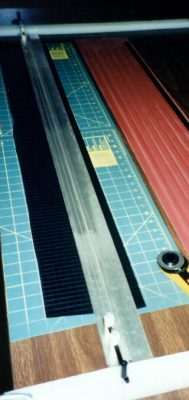 SM: I used Olfa rotary cutters and an Olfa cutting mat for the first time — very nice!! Now I’m just waiting for them to go on sale. 🙂
SM: I used Olfa rotary cutters and an Olfa cutting mat for the first time — very nice!! Now I’m just waiting for them to go on sale. 🙂
I learned: *That spray adhesive isn’t as nasty as I expected it to be. In fact, I can see how a person could easily get into the habit of using it!! *3M #6065 spray mount adhesive IS DIFFERENT from other brands and types; *Next time I’ll have to remember to bring some solvent for cleanup.
Oh, I also learned that I need more practice tying knots. ….. How does that bowline knot rhyme go again?? “Around the pole and through the hole….” ?? You can learn from classmates as well as from the instructor!
EG: I was delighted by my finished kite, and promptly took it out to fly, and by the end of Saturday I was suffering from power kite sewing overload and settled into wine flavoured exhaustion.
Taking two power sewing classes meant I was unable to visit any of the other classes; however, Saturday’s good weather saw many little fighter kites darting over the fields, products of Jonny Hsiung’s class. Miniatures bobbed around, indoors and out…products of Charlie Sotich’s and Dan Kurahashi’s classes on miniatures. The occasional circoflex bounced brightly across the field. Particpants in Brooks Leffler’s KAP class were walking around with their cameras in hand and a look of euphoria as they contemplated the heights from which they could photograph the world! Litte crazy looking maniacal faced kites emerged from Scott Hampton’s classroom and a concert of flute playing Kokopelis emerged from Gail Lindsay’s workshop on della Portas.
Sunday morning I decided to go low key…no more sewing machines for me. I finally was able to attend one of Charlie Sotich’s miniature kite classes. It was pure unadulterated fun. I am hooked on miniatures!!! What I thought was so difficult is really so simple.
What I learned in Charlie’s class: Never ignore an attractive napkin Tacky glue is VERY tacky Miniatures mostly fly on a single line, and don’t need complex bridling. I should have saved all that xmas tinsel for kite tails
 SM: After surviving the roller class — and in ONE DAY! — I had the opportunity to take in some of Sunday morning’s offerings. Decisions, decisions. Do I haul out the sewing machine once again and take Gary Engvall’s circoflex class (ooooh I’ve long wanted to build that one), or should I just try to soak up as much as possible by popping into other classes to audit them, and buy their kits? I chose the latter.
SM: After surviving the roller class — and in ONE DAY! — I had the opportunity to take in some of Sunday morning’s offerings. Decisions, decisions. Do I haul out the sewing machine once again and take Gary Engvall’s circoflex class (ooooh I’ve long wanted to build that one), or should I just try to soak up as much as possible by popping into other classes to audit them, and buy their kits? I chose the latter.
I learned: *Mary Yoshimi’s “Best Cicada” is one I could use at school with my middle years students. Mary also showed me how hollow plastic blind slats can be used as an alternative to bamboo. *I learned a simpler way to bow a kite and … *I learned how to tie another knot!!
Charlie Sotich shared the secrets of building miniature napkin kites. I learned that the local dollar store is a treasure trove of miniature kite building supplies, including thread, reels, and framing needs. Furthermore, I’ll be sure to try out the rubber stamped tissue paper ideas I picked up.
Chris Matheson showed participants how he uses a marked template to prepare the panels of a stunt kite sail before sewing. Very cool. I’m sure he had lots of other great tips and kite wisdom to pass along but I really had to fly…..
I wish I’d arrived at Achim Kinter’s presentation earlier.. WOW!! Achim shared his collection of historical kites — full scale reproductions of kites such as the French Military and other man-lifting wonders.
Gary Engvall has bridle line measurement down to a science in his circoflex class. Gary’s circoflex framing kit stares at me, begging to become airborne as I type…
You just can’t do it all–believe me–I tried. I was long overdue for a heavy dose of kite building, ready for some marathon sewing, so I registered for as many classes as I felt I could squeeze in.
Some participants opted for a more relaxed schedule. Take Penny Lingenfelter, for example. She didn’t register for any classes at all. Penny came to Fort Worden for just one day, to “network”. With close to 200 registered participants and 22 teachers, it was a great place to network, that’s for sure. I’m a little bit shy around strangers, but I tried to sit at different tables with different people at mealtimes. After all, kiters are like “family” right? I enjoyed the opportunity to put faces, voices, and personalities, to people I’d only read about in magazines. I do hope to go again next year. Maybe I should offer to teach a class…..
EG: I thoroughly enjoyed this year’s Spring Fling. Participants said a regretful goodbye to Robin Haas, who retired this year as president of the Fort Worden Retreat Board. Under Robin, the retreat has grown and flourished. In the past we have had international presenters from England, France, Germany, Japan, New Zealand and Canada. We are both looking forward to next year’s offerings and hoping that this time Fort Worden might go ‘Commonwealth’ and bring us presenters from Australia, Canada and maybe Malaysia!!
Sharon Musto (left) and Elain Genser (right) are award-winning kitemakers.

